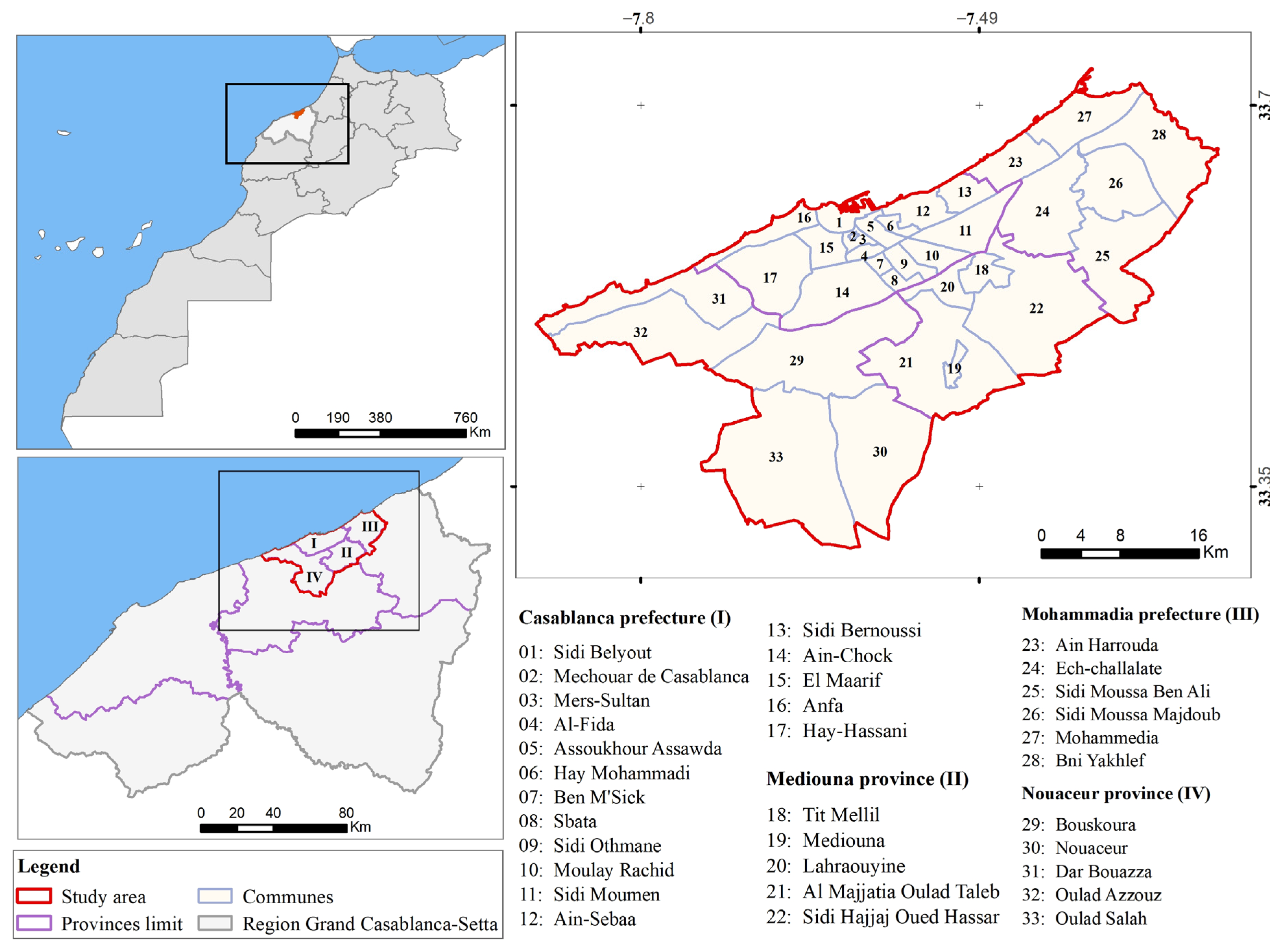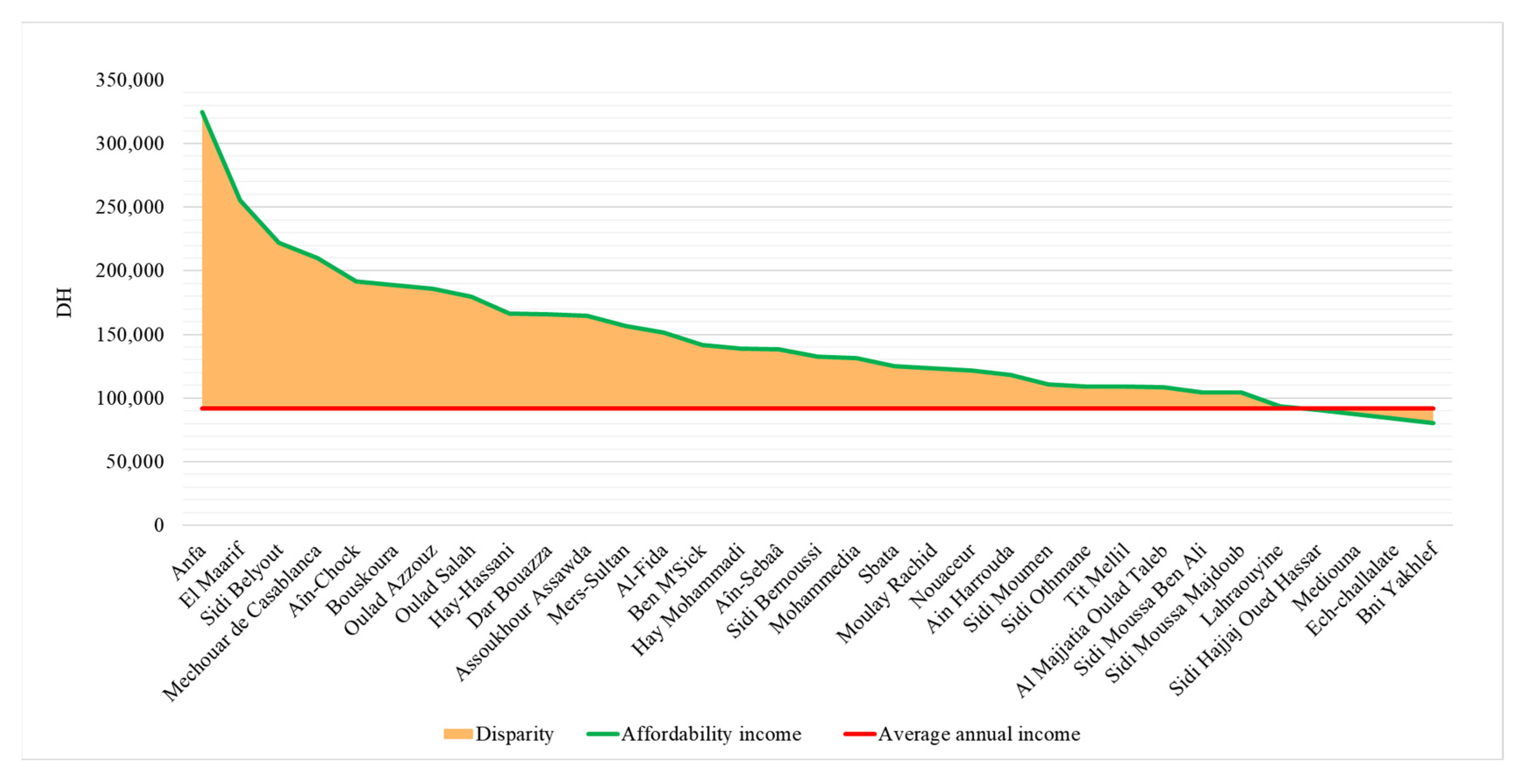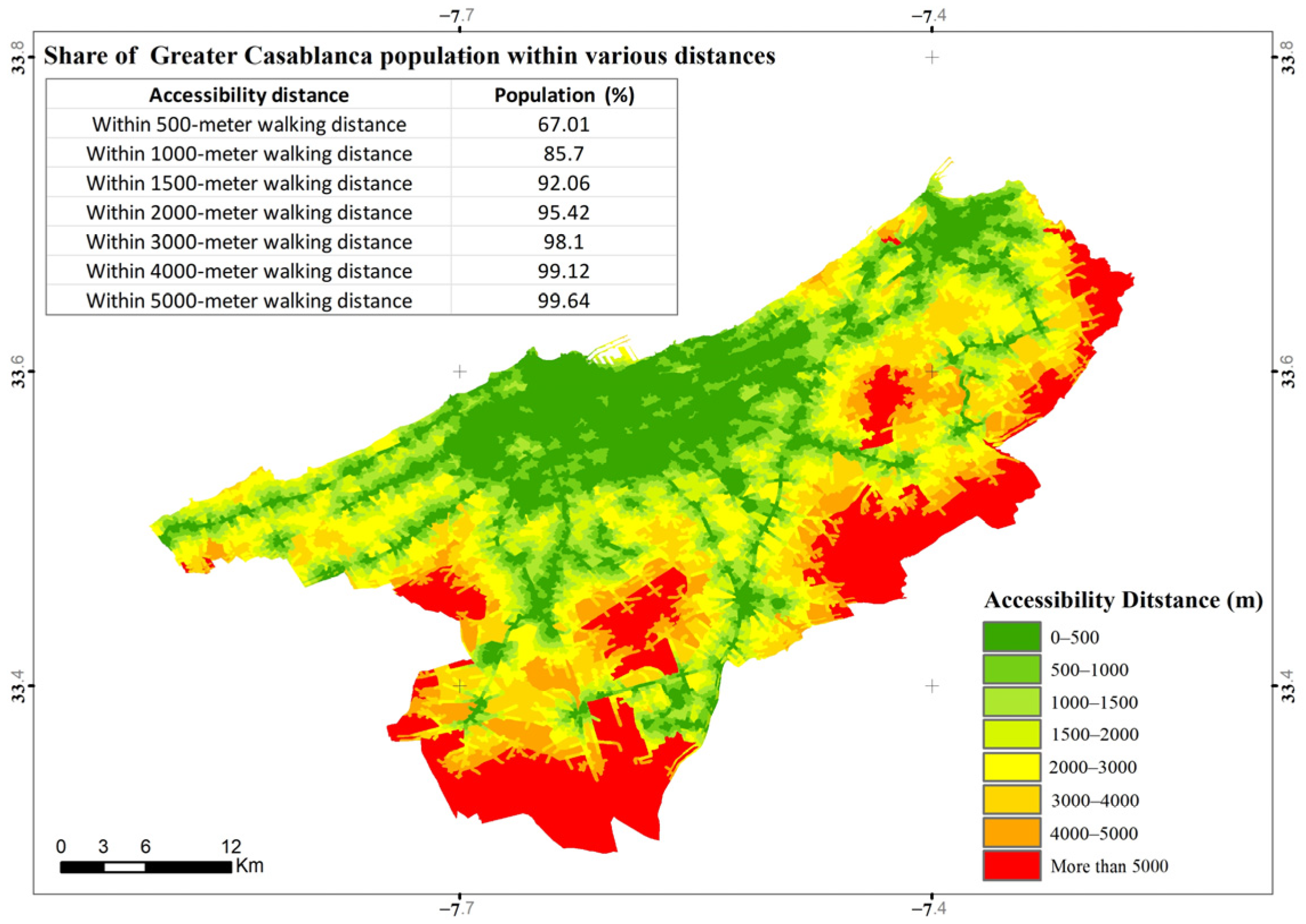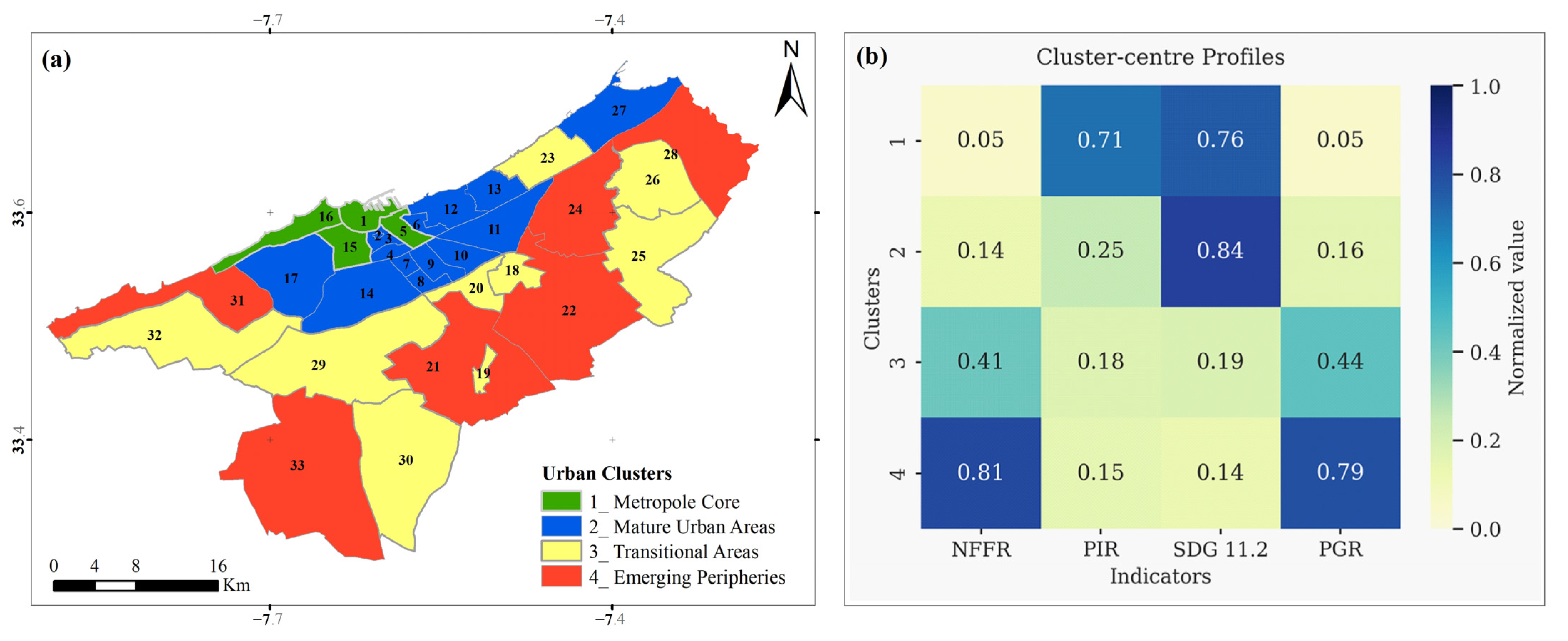Core–Periphery Dynamics and Spatial Inequalities in the African Context: A Case Study of Greater Casablanca
Abstract
1. Introduction
2. Methodology
2.1. Study Area
2.2. Data Sources
2.3. Methods
- (1)
- Computation of Indicators
- Sustainable urbanization: SDG 11.3.1
- Housing Affordability: Price-to-Income Ratio (PIR)
- Economic vitality: New Firm Formation Rate (NFFR)
- Public Transport Accessibility: SDG 11.2
- (2)
- Data harmonization and normalization
- (3)
- Exploratory analysis
- (4)
- Regression analysis
- (5)
- Clustering Analysis for Commune Classification:
3. Results
3.1. Urbanization Sustainability
3.1.1. Population Dynamics
3.1.2. Land Consumption
3.1.3. SDG 11.3.1
3.2. Housing Affordability
3.3. Economic Activity
3.4. Public Transport Accessibility and Connectivity Gaps
3.5. Correlation Analysis
3.6. Determinants of Population Growth
3.7. Clustering Analysis and Urban Typologies in Greater Casablanca
- Model-selection diagnostics
- Metropolitan typology
- Robustness check: hierarchical clustering
4. Discussion
4.1. Key Findings and Theoretical Implications
4.2. Economic Dynamism and Housing Policy as Drivers of Peripheral Growth
4.3. Public-Transport Accessibility and Spatial Inequalities
4.4. Lessons from North-African and Global Metropolitan Dynamics
4.5. Moving Towards a Sustainable Metropolitan Future: Policy Implications
4.6. Limitations and Future Research
5. Conclusions
Supplementary Materials
Author Contributions
Funding
Data Availability Statement
Conflicts of Interest
References
- United Nations, 2018 World Urbanization Prospects—Population Division—United Nations. Available online: https://population.un.org/wup/ (accessed on 24 September 2022).
- Martinez-Fernandez, C.; Weyman, T.; Fol, S.; Audirac, I.; Cunningham-Sabot, E.; Wiechmann, T.; Yahagi, H. Shrinking Cities in Australia, Japan, Europe and the USA: From a Global Process to Local Policy Responses. Prog. Plan. 2016, 105, 1–48. [Google Scholar] [CrossRef]
- Zhai, W.; Jiang, Z.; Meng, X.; Zhang, X.; Zhao, M.; Long, Y. Satellite Monitoring of Shrinking Cities on the Globe and Containment Solutions. iScience 2022, 25, 104411. [Google Scholar] [CrossRef] [PubMed]
- HCP Site Institutionnel du Haut-Commissariat au Plan du Royaume du Maroc. Available online: https://www.hcp.ma (accessed on 18 December 2024).
- Gans, P. Urban Population Development in Germany (2000–2014): The Contribution of Migration by Age and Citizenship to Reurbanisation. Comp. Popul. Stud. 2017, 42. [Google Scholar] [CrossRef]
- Baum-Snow, N. Did Highways Cause Suburbanization? Q. J. Econ. 2007, 122, 775–805. [Google Scholar] [CrossRef]
- Garcia-López, M.-À.; Pasidis, I.; Viladecans-Marsal, E. Suburbanization and Transportation in European Cities. J. Econ. Geogr. 2024, 24, 843–869. [Google Scholar] [CrossRef]
- Couch, C.; Karecha, J.; Nuissl, H.; Rink, D. Decline and Sprawl: An Evolving Type of Urban Development—Observed in Liverpool and Leipzig. Eur. Plan. Stud. 2005, 13, 117–136. [Google Scholar] [CrossRef]
- Klimczuk, A.; Klimczuk-Kochańska, M. Core-Periphery Model. In The Palgrave Encyclopedia of Global Security Studies; Palgrave Macmillan: Cham, Switzerland, 2019; pp. 1–8. ISBN 978-3-319-74336-3. [Google Scholar]
- Friedmann, J. Regional Development Policy: A Case Study of Venezuela; MIT Press: Cambridge, MA, USA, 1966; ISBN 978-0-262-06013-4. [Google Scholar]
- Buchholz, T. Seeking Spatial Justice—By EDWARD SOJA. Tijdschr. Econ. Soc. Geogr. 2011, 102, 378–380. [Google Scholar] [CrossRef]
- Harvey, D. The Right to the City: New Left Review. In The City Reader; Routledge: London, UK, 2008; pp. 23–40. [Google Scholar]
- Haase, A.; Rink, D.; Grossmann, K.; Bernt, M.; Mykhnenko, V. Conceptualizing Urban Shrinkage. Environ. Plan. A 2014, 46, 1519–1534. [Google Scholar] [CrossRef]
- Wu, K.; Yao, C. Exploring the Association between Shrinking Cities and the Loss of External Investment: An Intercity Network Analysis. Cities 2021, 119, 103351. [Google Scholar] [CrossRef]
- Rousseau, M.; Harroud, T. When Urban Shrinkage Goes South. Morocco’s Extreme Management of Declining Mining Towns between Paternalism, Entrepreneurialism and Abandonment. Political Geogr. 2023, 106, 102954. [Google Scholar] [CrossRef]
- Liu, L.; Peng, Z.; Wu, H.; Jiao, H.; Yu, Y.; Zhao, J. Fast Identification of Urban Sprawl Based on K-Means Clustering with Population Density and Local Spatial Entropy. Sustainability 2018, 10, 2683. [Google Scholar] [CrossRef]
- Chettry, V. A Critical Review of Urban Sprawl Studies. J. Geovis. Spat. Anal. 2023, 7, 28. [Google Scholar] [CrossRef]
- Malaker, T.; Meng, Q. Urban Disparity Analytics Using GIS: A Systematic Review. Sustainability 2024, 16, 5956. [Google Scholar] [CrossRef]
- Bahi, H.; Rhinane, H.; Bensalmia, A.; Fehrenbach, U.; Scherer, D. Effects of Urbanization and Seasonal Cycle on the Surface Urban Heat Island Patterns in the Coastal Growing Cities: A Case Study of Casablanca, Morocco. Remote Sens. 2016, 8, 829. [Google Scholar] [CrossRef]
- Tayi, S.; Radoine, H.; El-Bouayady, R. Assessing Urban Sustainability with Geospatial Technologies: Mapping Public Transport Accessibility in Casablanca to Support SDG 11.2. In Proceedings of the International Conference on Emerging Technologies and Innovation for Sustainability (EmergIN), Greater Noida, India, 20–21 December 2024; Institute of Electrical and Electronics Engineers Inc.: New York, NY, USA, 2024; pp. 152–156. [Google Scholar]
- Carioli, A.; Schiavina, M.; Freire, S.; MacManus, K. GHS-POP R2023A—GHS Population Grid Multitemporal (1975–2030); European Commission, Joint Research Centre (JRC): Brussels, Belgium, 2023. [Google Scholar]
- Gong, P.; Li, X.; Wang, J.; Bai, Y.; Chen, B.; Hu, T.; Liu, X.; Xu, B.; Yang, J.; Zhang, W.; et al. Annual Maps of Global Artificial Impervious Area (GAIA) between 1985 and 2018. Remote Sens. Environ. 2020, 236, 111510. [Google Scholar] [CrossRef]
- UN, H. Metadata on SDGs Indicator 11.3.1. Available online: https://unhabitat.org/sites/default/files/2020/07/metadata_on_sdg_indicator_11.3.1.pdf (accessed on 15 January 2024).
- Lynch, C.; Singh, A.; Zhang, Y.F. Towards a More Nuanced Approach to Measuring Housing Affordability: Evidence from Pakistan; Policy Research Working Papers; The World Bank: Washington, DC, USA, 2023. [Google Scholar]
- UN-Habitat. Global Urban Indicators Database. United Nations Human Settlements Programme; UN-Habitat: Nairobi, Kenya, 2002. [Google Scholar]
- Cox, W. Demographia International Housing Affordability, 2024 Edition; Frontier Centre for Public Policy: Winnipeg, MB, Canada, 2024. [Google Scholar]
- Moiz, M.; Ileri, Ş.G. The Relationship Between Firm Formation and Unemployment: Evidence from Türkiye. Economies 2025, 13, 28. [Google Scholar] [CrossRef]
- Mączka, M. Accessibility model for the evaluation of transport infrastructure policy. Pr. Inst. Lotnictwa 2016, 245, 116–133. [Google Scholar] [CrossRef]
- Hauke, J.; Kossowski, T. Comparison of Values of Pearson’s and Spearman’s Correlation Coefficients on the Same Sets of Data. Quaest. Geogr. 2011, 30, 87–93. [Google Scholar] [CrossRef]
- Dadashpoor, H.; Malekzadeh, N. Evolving Spatial Structure of Metropolitan Areas at a Global Scale: A Context-Sensitive Review. GeoJournal 2022, 87, 4335–4362. [Google Scholar] [CrossRef]
- El-Bouayady, R.; Radoine, H.; El Faouzi, N.-E.; Tayi, S.; Ozkan, H.C. Assessing and Modeling the Impact of Urbanization on Infrastructure Development in Africa: A Data-Driven Approach. Cities 2024, 155, 105486. [Google Scholar] [CrossRef]
- Henderson, V. The Urbanization Process and Economic Growth: The So-What Question. J. Econ. Growth 2003, 8, 47–71. [Google Scholar] [CrossRef]
- Yang, J.; Li, J.; Xu, F.; Li, S.; Zheng, M.; Gong, J. Urban Development Wave: Understanding Physical Spatial Processes of Urban Expansion from Density Gradient of New Urban Land. Comput. Environ. Urban Syst. 2022, 97, 101867. [Google Scholar] [CrossRef]
- Turok, I.; McGranahan, G. Urbanization and Economic Growth: The Arguments and Evidence for Africa and Asia. Environ. Urban. 2013, 25, 465–482. [Google Scholar] [CrossRef]
- Storper, M.; Scott, A.J. Current Debates in Urban Theory: A Critical Assessment. Urban Stud. 2016, 53, 1114–1136. [Google Scholar] [CrossRef]
- Schiavina, M.; Melchiorri, M.; Freire, S.; Florio, P.; Ehrlich, D.; Tommasi, P.; Pesaresi, M.; Kemper, T. Land Use Efficiency of Functional Urban Areas: Global Pattern and Evolution of Development Trajectories. Habitat Int. 2022, 123, 102543. [Google Scholar] [CrossRef]
- Agence Urbaine de Casablanca, Schéma Directeur d’Aménagement Urbain Du Grand Casablanca. Available online: https://www.auc.ma/gestion-planification-urbaine/schema-directeur-damenagement-urbain/ (accessed on 1 October 2025).
- Côté-Roy, L.; Moser, S. “Fast Urban Model-Making”: Constructing Moroccan Urban Expertise through Zenata Eco-City. Urban Geogr. 2023, 44, 2016–2036. [Google Scholar] [CrossRef]
- Beier, R. The World-Class City Comes by Tramway: Reframing Casablanca’s Urban Peripheries through Public Transport. Urban Stud. 2020, 57, 1827–1844. [Google Scholar] [CrossRef]
- UN-Habitat. World Cities Report 2020: The Value of Sustainable Urbanization; UN-Habitat: Nairobi, Kenya, 2020. [Google Scholar]
- Bueno Rezendede Castro, A.; Ortega Sandoval, A.D.; Odamtten, G. Up around the Bend? How Transport Poverty Can Lead to Social Exclusion in a Low-Income Community in Lagos, Nigeria. J. Transp. Geogr. 2022, 102, 103388. [Google Scholar] [CrossRef]
- Safar Zitoun, M. Alger d’aujourd’hui: Une ville à la recherche de ses marques sociales. Rev. Algér. D’anthropologie Sci. Soc. 2009, 13, 33–55. [Google Scholar] [CrossRef]
- Trache, S.; Khelifi, M. Périurbanisation et décroissance démographique de la ville centre: L’exemple d’Oran (Algérie). Cah. Géogr. Qué. 2020, 64, 169–189. [Google Scholar] [CrossRef]
- Elhamdouni, S.; Idrissi, Y.; Cherkaoui, E.; Nounah, A.; Khamar, M. Dynamics of Urbanization in the City of Rabat-Morocco, Which Sustainable Transition? Civ. Environ. Eng. 2024, 20, 1140–1151. [Google Scholar] [CrossRef]
- Salem, M.; Tsurusaki, N.; Xu, X.; Xu, G. Revealing the Transformation of Spatial Structure of Greater Cairo: Insights from Satellite Imagery and Geospatial Metrics. J. Urban Manag. 2024, 13, 565–579. [Google Scholar] [CrossRef]
- Alillouch, R.; Harroud, T. The “New Generation” of New Cities in Morocco: From the “Dormitory” City to the “Sustainable” City, What Has Changed? Afr. Mediterr. J. Archit. Urban. 2022, 4, 99–122. [Google Scholar] [CrossRef]
- Yang, J.; Zhou, J. Metropolitan Shenzhen: Rail Plus Property for Transit-Oriented Development; Greater Than Parts Case Study No. 9; World Bank: Washington, DC, USA, 2020. [Google Scholar]






| Data | Source | Type | Resolution/Details |
|---|---|---|---|
| Population Spatial Distribution | Global Population Surfaces (GHSL Pop) | Remote sensing | 100 m resolution population density grids (2025) [21] |
| Population Data | High Commission for Planning (HCP) | Statistical Data | Annual population statistics by commune (2004, 2014, 2024) [4] |
| Built-Up Area Data | Gaia Dataset | Remote sensing | 30 m resolution global built-up area (2014–2024) [22] |
| Administrative Boundaries | High Commission for Planning (HCP) | Geospatial Data | Commune-level boundaries (2024) [4] |
| Housing Price | National Council of Notaries of Morocco (CNONM) | Geospatial Data | This is a reference for real estate prices in Morocco published by National Council of Notaries of Morocco. |
| Economic Establishments in Greater Casablanca | High Commission for Planning (HCP) | Static data | The dataset provides statistics on economic establishments created between 2010 and 2024, extracted from the Cartography of Economic Establishments (CEE 2023–2024) [4] |
| Public Transport Stops | OpenStreetMap (OSM) | Geospatial Data | Geolocated public transport stops (tram and bus, 2024) |
| Road Network | OpenStreetMap (OSM) | Geospatial Data | Detailed road network (2024) |
| Area | Population 2014 | Population 2024 | PGR (%) | LCR (%) | LCRPGR |
|---|---|---|---|---|---|
| Casablanca prefecture | 3,359,818 | 3,218,036 | −0.43 | 0.41 | −0.94 |
| Mediouna province | 172,680 | 345,787 | 6.94 | 2.80 | 0.40 |
| Mohammadia prefecture | 404,648 | 514,057 | 2.39 | 1.10 | 0.46 |
| Nouaceur province | 333,604 | 672,324 | 7.01 | 2.53 | 0.36 |
| Greater Casablanca | 4,270,750 | 4,750,204 | 1.06 | 0.82 | 0.77 |
| Province | Commune | SDG 11.2 | Province | Commune | SDG 11.2 |
|---|---|---|---|---|---|
| Casablanca | Sbata | 95.55 | Mohammadia | Ain Harrouda | 32.01 |
| Mechouar de Casablanca | 58.26 | Bni Yakhlef | 33 | ||
| Aîn-Chock | 78.04 | Ech-challalate | 20.57 | ||
| Aîn-Sebaâ | 81.40 | Sidi Moussa Ben Ali | 13.02 | ||
| Hay Mohammadi | 93.60 | Sidi Moussa Majdoub | 20.51 | ||
| Mers-Sultan | 97.78 | Mohammedia | 65.79 | ||
| Sidi Bernoussi | 76.53 | Mohammedia | 65.79 | ||
| Sidi Moumen | 65.99 | Nouaceur | Bouskoura | 25.03 | |
| Sidi Othmane | 74.79 | Nouaceur | 15.57 | ||
| Hay-Hassani | 82.18 | Dar Bouazza | 24.58 | ||
| Moulay Rachid | 84.54 | Oulad Azzouz | 11.64 | ||
| Sidi Belyout | 82.84 | Oulad Salah | 27.16 | ||
| Anfa | 71.45 | Mediouna | Tit Mellil | 37.47 | |
| Al-Fida | 99.04 | Mediouna | 68.05 | ||
| Assoukhour Assawda | 95.80 | Lahraouyine | 45.94 | ||
| Ben M’Sick | 98.12 | Al Majjatia Oulad Taleb | 20.96 | ||
| El Maarif | 93.10 | Sidi Hajjaj Oued Hassar | 14.43 |
| Indicator Pair | PGR | NFFR | SDG11.2 | PIR |
|---|---|---|---|---|
| PGR | 1.00 (−) | 0.93 [0.85–0.96] < 0.001 | −0.76 [–0.86–−0.58]; <0.001 | −0.48 [–0.77–−0.11]; 0.006 |
| NFFR | 0.93 [0.85–0.96]; <0.001 | 1.00 (–) | −0.78 [–0.88–−0.60]; <0.001 | −0.55 [–0.80–−0.23]; 0.001 |
| SDG11.2 | −0.76 [–0.86–−0.58]; <0.001 | −0.78 [–0.88–−0.60]; <0.001 | 1.00 (−) | 0.35 [0.01–0.63]; 0.048 |
| PIR | −0.48 [–0.77–−0.11]; 0.006 | −0.55 [–0.80–−0.23]; 0.001 | 0.35 [0.01–0.63]; 0.048 | 1.00 (−) |
| (I): Baseline Model | (II): Affordability Model | (III): NFFR and PT Model | (IV): Reduced Model | (V): Interaction Model | (VI): Core-Periphery Model | |
|---|---|---|---|---|---|---|
| 0.152 *** (0.052) | 0.151 *** (0.051) | 0.172 *** (0.051) | 0.084 (0.118) | 0.156 *** (0.052) | ||
| −0.027 (0.027) | −0.028 (0.021) | −0.029 (0.030) | −0.028 (0.024) | |||
| 0.023 (0.345) | −0.037 (0.278) | −0.548 (0.418) | −0.020 (0.230) | |||
| 0.108 (0.161) | 0.433 *** (0.104) | 0.103 (0.104) | 0.151 (0.102) | −0.452 (0.513) | ||
| 0.005 (0.006) | ||||||
| 0.000 (0.003) | ||||||
| 0.063 (0.050) | ||||||
| core_periphery | 1.269 (1.089) | |||||
| 0.769 | 0.537 | 0.769 | 0.757 | 0.813 | 0.765 | |
| Adj. | 0.726 | 0.506 | 0.745 | 0.741 | 0.760 | 0.731 |
| AIC | 160.5 | 177.5 | 156.5 | 156.1 | 157.6 | 159.1 |
| BIC | 171.0 | 183.4 | 164.0 | 162.1 | 171.1 | 168.0 |
| Log.Lik. | −73.245 | −84.730 | −73.254 | −74.065 | −69.804 | −73.530 |
| RMSE | 2.23 | 3.15 | 2.23 | 2.28 | 2.01 | 2.25 |
Disclaimer/Publisher’s Note: The statements, opinions and data contained in all publications are solely those of the individual author(s) and contributor(s) and not of MDPI and/or the editor(s). MDPI and/or the editor(s) disclaim responsibility for any injury to people or property resulting from any ideas, methods, instructions or products referred to in the content. |
© 2025 by the authors. Licensee MDPI, Basel, Switzerland. This article is an open access article distributed under the terms and conditions of the Creative Commons Attribution (CC BY) license (https://creativecommons.org/licenses/by/4.0/).
Share and Cite
Tayi, S.; El-Bouayady, R.; Bahi, H. Core–Periphery Dynamics and Spatial Inequalities in the African Context: A Case Study of Greater Casablanca. Urban Sci. 2025, 9, 420. https://doi.org/10.3390/urbansci9100420
Tayi S, El-Bouayady R, Bahi H. Core–Periphery Dynamics and Spatial Inequalities in the African Context: A Case Study of Greater Casablanca. Urban Science. 2025; 9(10):420. https://doi.org/10.3390/urbansci9100420
Chicago/Turabian StyleTayi, Soukaina, Rachida El-Bouayady, and Hicham Bahi. 2025. "Core–Periphery Dynamics and Spatial Inequalities in the African Context: A Case Study of Greater Casablanca" Urban Science 9, no. 10: 420. https://doi.org/10.3390/urbansci9100420
APA StyleTayi, S., El-Bouayady, R., & Bahi, H. (2025). Core–Periphery Dynamics and Spatial Inequalities in the African Context: A Case Study of Greater Casablanca. Urban Science, 9(10), 420. https://doi.org/10.3390/urbansci9100420






